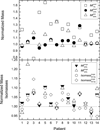Dose-mass inverse optimization for minimally moving thoracic lesions
- PMID: 25909516
- PMCID: PMC4426070
- DOI: 10.1088/0031-9155/60/10/3927
Dose-mass inverse optimization for minimally moving thoracic lesions
Abstract
In the past decade, several different radiotherapy treatment plan evaluation and optimization schemes have been proposed as viable approaches, aiming for dose escalation or an increase of healthy tissue sparing. In particular, it has been argued that dose-mass plan evaluation and treatment plan optimization might be viable alternatives to the standard of care, which is realized through dose-volume evaluation and optimization. The purpose of this investigation is to apply dose-mass optimization to a cohort of lung cancer patients and compare the achievable healthy tissue sparing to that one achievable through dose-volume optimization. Fourteen non-small cell lung cancer (NSCLC) patient plans were studied retrospectively. The range of tumor motion was less than 0.5 cm and motion management in the treatment planning process was not considered. For each case, dose-volume (DV)-based and dose-mass (DM)-based optimization was performed. Nine-field step-and-shoot IMRT was used, with all of the optimization parameters kept the same between DV and DM optimizations. Commonly used dosimetric indices (DIs) such as dose to 1% the spinal cord volume, dose to 50% of the esophageal volume, and doses to 20 and 30% of healthy lung volumes were used for cross-comparison. Similarly, mass-based indices (MIs), such as doses to 20 and 30% of healthy lung masses, 1% of spinal cord mass, and 33% of heart mass, were also tallied. Statistical equivalence tests were performed to quantify the findings for the entire patient cohort. Both DV and DM plans for each case were normalized such that 95% of the planning target volume received the prescribed dose. DM optimization resulted in more organs at risk (OAR) sparing than DV optimization. The average sparing of cord, heart, and esophagus was 23, 4, and 6%, respectively. For the majority of the DIs, DM optimization resulted in lower lung doses. On average, the doses to 20 and 30% of healthy lung were lower by approximately 3 and 4%, whereas lung volumes receiving 2000 and 3000 cGy were lower by 3 and 2%, respectively. The behavior of MIs was very similar. The statistical analyses of the results again indicated better healthy anatomical structure sparing with DM optimization. The presented findings indicate that dose-mass-based optimization results in statistically significant OAR sparing as compared to dose-volume-based optimization for NSCLC. However, the sparing is case-dependent and it is not observed for all tallied dosimetric endpoints.
Figures


Similar articles
-
Dose to mass for evaluation and optimization of lung cancer radiation therapy.Radiother Oncol. 2017 Nov;125(2):344-350. doi: 10.1016/j.radonc.2017.09.002. Epub 2017 Oct 12. Radiother Oncol. 2017. PMID: 29031611
-
Robust optimization in lung treatment plans accounting for geometric uncertainty.J Appl Clin Med Phys. 2018 May;19(3):19-26. doi: 10.1002/acm2.12291. Epub 2018 Mar 10. J Appl Clin Med Phys. 2018. PMID: 29524301 Free PMC article. Review.
-
Feasibility of sparing lung and other thoracic structures with intensity-modulated radiotherapy for non-small-cell lung cancer.Int J Radiat Oncol Biol Phys. 2004 Mar 15;58(4):1268-79. doi: 10.1016/j.ijrobp.2003.09.085. Int J Radiat Oncol Biol Phys. 2004. PMID: 15001272
-
Impact of dose calculation accuracy during optimization on lung IMRT plan quality.J Appl Clin Med Phys. 2015 Jan 8;16(1):5137. doi: 10.1120/jacmp.v16i1.5137. J Appl Clin Med Phys. 2015. PMID: 25679172 Free PMC article. Clinical Trial.
-
Reducing dose to the lungs through loosing target dose homogeneity requirement for radiotherapy of non small cell lung cancer.J Appl Clin Med Phys. 2017 Nov;18(6):169-176. doi: 10.1002/acm2.12200. Epub 2017 Oct 11. J Appl Clin Med Phys. 2017. PMID: 29024297 Free PMC article.
Cited by
-
Automated inverse optimization facilitates lower doses to normal tissue in pancreatic stereotactic body radiotherapy.PLoS One. 2018 Jan 19;13(1):e0191036. doi: 10.1371/journal.pone.0191036. eCollection 2018. PLoS One. 2018. PMID: 29351303 Free PMC article.
-
New approach in lung cancer radiotherapy offers better normal tissue sparing.Radiother Oncol. 2016 Nov;121(2):316-321. doi: 10.1016/j.radonc.2016.09.008. Epub 2016 Sep 28. Radiother Oncol. 2016. PMID: 27692398 Free PMC article.
References
-
- Aaltonen P, Brahme A, Lax I, Levernes S, Naslund I, Reitan JB, Turesson I. Specification of dose delivery in radiation therapy. Recommendation by the Nordic Association of Clinical Physics (NACP) Acta oncologica (Stockholm, Sweden) 1997;36(Suppl 10):1–32. - PubMed
-
- American Cancer Society. Cancer Facts and Figures 2014. American Cancer Society. 2014
-
- Anscher MS, Marks LB, Shafman TD, Clough R, Huang H, Tisch A, Munley M, Herndon JE, Garst J, Crawford J, Jirtle RL. Risk of long-term complications after TFG-beta1-guided very-high-dose thoracic radiotherapy. International journal of radiation oncology, biology, physics. 2003;56:988–995. - PubMed
-
- Auperin A, Le Pechoux C, Pignon JP, Koning C, Jeremic B, Clamon G, Einhorn L, Ball D, Trovo MG, Groen HJ, Bonner JA, Le Chevalier T, Arriagada R. Concomitant radio-chemotherapy based on platin compounds in patients with locally advanced non-small cell lung cancer (NSCLC): a meta-analysis of individual data from 1764 patients. Ann oncol. 2006;17:473–483. - PubMed
-
- Belderbos J, Heemsbergen W, Hoogeman M, Pengel K, Rossi M, Lebesque J. Acute esophageal toxicity in non-small cell lung cancer patients after high dose conformal radiotherapy. Radiother oncol. 2005;75:157–164. - PubMed
Publication types
MeSH terms
Grants and funding
LinkOut - more resources
Full Text Sources
Other Literature Sources
Miscellaneous
